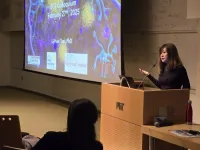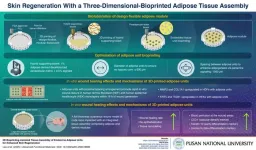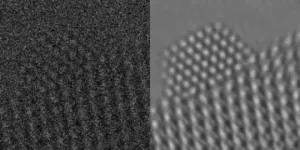(Press-News.org) Caring for a baby is a full-time job, often causing new mothers to overlook their own health needs. This situation is exemplified by the low compliance with postpartum glucose screening among women who had gestational diabetes—a condition that significantly increases their risk of developing type 2 diabetes later in life.
Now new research published today in Diabetes Care indicates that a shorter, one-hour glucose tolerance test outperforms the standard two-hour test in predicting future risk of diabetes and could transform clinical practice.
The research was led by Dr. Ravi Retnakaran, a Clinician Scientist at the Lunenfeld-Tanenbaum Research Institute, an Endocrinologist at the Leadership Sinai Centre for Diabetes at Mount Sinai Hospital where he holds the Boehringer Ingelheim Chair in Beta-cell Preservation, Function and Regeneration.
“Gestational diabetes provides a unique opportunity to identify a very high risk of a major future illness at a young age, “ said Dr. Retnakaran, who is also a Professor at the University of Toronto’s Temerty Faculty of Medicine. “It is for this reason that, after having gestational diabetes, it is recommended that women do an oral glucose tolerance test within 6 months of delivery.”
“But the reality is that many women don’t come back to do this test. The first six months postpartum are hectic, and finding time for a two-hour test is challenging," he said.
Pregnancy acts as a stress test that can indicate a woman’s predisposition to type 2 diabetes, as the increased demands on the body can reveal underlying limitations in their capacity to produce enough insulin for blood sugar control. Women with gestational diabetes are seven to ten times more likely to develop diabetes later, making postpartum testing crucial.
Only about half of these women return for their glucose tests, however. The gold standard two-hour Oral Glucose Tolerance Test (OGTT) requires women to fast overnight and then complete the test the next morning, at which time blood is drawn for measurement of their blood sugar, followed by consumption of a sugar drink, and then waiting for two hours for repeat blood sugar measurement.
Time constraints are not the only issue. There's also often confusion over which health-care provider should order the test, be it an endocrinologist, obstetrician or a primary care physician, said Dr. Retnakaran. And the problem persists not only in Canada but also globally, including the U.S., Australia, China, and across the European Union.
Recognizing the issue, the International Diabetes Federation last year recommended shortening the test duration to one hour, citing evidence that this timeframe is not only more practical but also more sensitive. Research has shown that the one-hour test captures the peak blood sugar levels. If the blood sugar level is high at this point, it suggests that the body is not processing glucose efficiently, identifying an elevated risk of developing diabetes.
Dr. Retnakaran, who has dedicated his research career to understanding the underlying biology of gestational diabetes and its impact on future health, was well-placed to assess the effectiveness of the one-hour test for postpartum screening. His team follows a large cohort of women diagnosed with gestational diabetes for several years post-pregnancy. Their latest study compared the predictive capabilities of the one-hour and two-hour tests at three months postpartum for pre-diabetes status at five years postpartum among 369 women. The one-hour test not only matched the 2-hour test but was even a stronger predictor of pre-diabetes status five years later.
This suggests that the one-hour OGTT could improve completion rates of testing after pregnancy and facilitate early intervention, potentially revolutionizing diabetes prevention for postpartum women.
Dr. Retnakaran’s findings are timely, as the global incidence of diabetes in pregnancy is rising, affecting one in six pregnancies globally. But there’s good news too.
“If you identify an individual who has risk of diabetes, one of the most effective interventions for reducing this risk is helping them to lose weight. And we are at a point in time where weight loss has never been more achievable for large numbers of people thanks to new medications that are now available,” said Dr. Retnakaran.
As a next step, Dr. Retnakaran plans to conduct a clinical trial to confirm if the one-hour test can indeed increase compliance before it can become standard practice.
END
New study suggests a shift in diabetes testing after pregnancy to improve women's health
A shorter glucose tolerance test outperforms the 2hr gold standard and could transform postpartum diabetes screening
2025-03-03
ELSE PRESS RELEASES FROM THIS DATE:
FOME alliance pioneers VR innovation in management education
2025-03-03
By pooling the resources and expertise from alliance members, the initiative addresses common challenges in VR adoption for education, such as high development costs and lack of in-house technical expertise. The module provides a device-agnostic, 3D and 2D-accessible VR experience, enabling immersive learning opportunities for students and executives worldwide. As part of the module, a 20-minute pilot scenario allows users to engage in crisis management exercises, honing their soft skills through interactions with a digital counterpart (avatar). By uniting under a shared mission, individual alliance members’ ...
Evidence expanding that 40Hz gamma stimulation promotes brain health
2025-03-03
A decade after scientists in The Picower Institute for Learning and Memory at MIT first began testing whether sensory stimulation of the brain’s 40Hz “gamma” frequency rhythms could treat Alzheimer’s disease in mice, a growing evidence base supporting the idea that it can improve brain health—in humans as well as animals—has emerged from the work of labs all over the world. A new review article in PLOS Biology describes the state of research so far and presents some of the fundamental and clinical questions at the forefront of the non-invasive gamma stimulation now.
“As ...
Teaching kids how to become better citizens
2025-03-03
COLUMBUS, Ohio – In our polarized society, a new study offers hope for the future: Even young children can learn to discuss and argue about meaningful problems in a respectful and productive way.
Researchers at The Ohio State University found success in a social studies curriculum for fourth graders based on teaching what they called “civic competencies.”
Over the course of a school year, findings showed that the students participating in the curriculum significantly improved their argumentation skills and disciplinary thinking.
“This will give them the ability to collaborate, communicate effectively and consider multiple perspectives”, ...
Pusan National University researchers develop a novel 3D adipose tissue bioprinting method
2025-03-03
The adipose tissue, which serves as an endocrine organ, releases various molecules that regulate the repair of other damaged tissues, including the skin. Hence, adipose tissues can potentially be reengineered to regenerate the damaged organs. Three-dimensional (3D) bioprinting technology has revolutionized regenerative medicine by enabling the generation of engineered and functional 3D organs or tissues, including adipose tissues. However, the currently used tissue biofabrication methods cannot replicate ...
Scientists use AI to better understand nanoparticles
2025-03-03
A team of scientists has developed a method to illuminate the dynamic behavior of nanoparticles, which are foundational components in the creation of pharmaceuticals, electronics, and industrial and energy-conversion materials. The advance, reported in the journal Science, combines artificial intelligence with electron microscopy to render visuals of how these tiny bits of matter respond to stimuli.
“Nanoparticle-based catalytic systems have a tremendous impact on society,” explains Carlos Fernandez-Granda, director of NYU’s Center for Data Science and a professor of mathematics and data science, one of the paper’s authors. “It is estimated that 90 percent ...
We feed gut microbes sugar, they make a compound we need
2025-03-03
Gut microbes that were thought to feed exclusively on dietary fiber also get fed sugar from our guts, from which they produce short-chain fatty acids that are crucial to many body functions. The Kobe University discovery of this symbiotic relationship also points the way to developing novel therapeutics.
Gut microbes produce many substances that our body needs but cannot produce itself. Among them are short-chain fatty acids that are the primary energy source for the cells lining our guts but have other important roles, too, and ...
One of the largest psychotherapy trials in the world has implications for transforming mental health care during pregnancy and after birth
2025-03-03
Approximately one in five of pregnant and postpartum individuals experience depression and anxiety, yet less than 10 per cent receive proper treatment.
To address this problem, a team of interdisciplinary researchers from Canada and the United States investigated if talk therapy can be effectively delivered by non-mental health specialists and telemedicine to increase access. In a paper published today in Nature Medicine, they share results from the Scaling Up Maternal Mental health care by Increasing access to Treatment (SUMMIT) Trial, which reveals promising strategies to provide the necessary support and treatment more effectively and inclusively ...
It’s not just what you say – it’s also how you say it
2025-03-03
EVANSTON, Ill. --- You’ve probably heard the phrase, “It’s not what you say, it’s how you say it,” and now, science backs it up. A first-of-its-kind study from Northwestern University’s School of Communication, the University of Pittsburgh and the University of Wisconsin-Madison reveals a region of the brain, long known for early auditory processing, plays a far greater role in interpreting speech than previously understood.
The multidisciplinary study being published Monday, March ...
Sleep patterns may reveal comatose patients with hidden consciousness
2025-03-03
NEW YORK, NY (March 3, 2025)--Several studies in the past decade have revealed that up to a quarter of unresponsive patients with recent brain injuries may possess a degree of consciousness that’s normally hidden from their families and physicians.
New research from Columbia University and NewYork-Presbyterian may soon help physicians identify unresponsive brain-injury patients with hidden consciousness who are likely to achieve long-term recovery by looking for brain waves that are indicative of normal sleep patterns.
“We’re at an exciting crossroad in neurocritical care where we know that many patients appear to be unconscious, but some are recovering without ...
3D genome structure guides sperm development
2025-03-03
Two new landmark studies show how a seeming tangle of DNA is actually organized into a structure that coordinates thousands of genes to form a sperm cell. The work, published March 3 as two papers in Nature Structural and Molecular Biology, could improve treatment for fertility problems and developmental disorders.
“We are finding the 3D structure of the genome,” said Satoshi Namekawa, professor of microbiology and molecular genetics at the University of California, Davis and senior author on one of the papers. “This is really showing us how the genomic architecture guides development.”
Although DNA is a long, stringy molecule, in living ...
LAST 30 PRESS RELEASES:
New expert guidance urges caution before surgery for patients with treatment-resistant constipation
Solar hydrogen can now be produced efficiently without the scarce metal platinum
Sleeping in on weekends may help boost teens’ mental health
Study: Teens use cellphones for an hour a day at school
After more than two years of war, Palestinian children are hungry, denied education and “like the living dead”
The untold story of life with Prader-Willi syndrome - according to the siblings who live it
How the parasite that ‘gave up sex’ found more hosts – and why its victory won’t last
When is it time to jump? The boiling frog problem of AI use in physics education
Twitter data reveals partisan divide in understanding why pollen season's getting worse
AI is quick but risky for updating old software
Revolutionizing biosecurity: new multi-omics framework to transform invasive species management
From ancient herb to modern medicine: new review unveils the multi-targeted healing potential of Borago officinalis
Building a global scientific community: Biological Diversity Journal announces dual recruitment of Editorial Board and Youth Editorial Board members
Microbes that break down antibiotics help protect ecosystems under drug pollution
Smart biochar that remembers pollutants offers a new way to clean water and recycle biomass
Rice genes matter more than domestication in shaping plant microbiomes
Ticking time bomb: Some farmers report as many as 70 tick encounters over a 6-month period
Turning garden and crop waste into plastics
Scientists discover ‘platypus galaxies’ in the early universe
Seeing thyroid cancer in a new light: when AI meets label-free imaging in the operating room
Neutrophil-to-lymphocyte ratio may aid risk stratification in depressive disorder
2026 Seismological Society of America Annual Meeting
AI-powered ECG analysis offers promising path for early detection of chronic obstructive pulmonary disease, says Mount Sinai researchers
GIMM uncovers flaws in lab-grown heart cells and paves the way for improved treatments
Cracking the evolutionary code of sleep
Medications could help the aging brain cope with surgery, memory impairment
Back pain linked to worse sleep years later in men over 65, according to study
CDC urges ‘shared decision-making’ on some childhood vaccines; many unclear about what that means
New research finds that an ‘equal treatment’ approach to economic opportunity advertising can backfire
Researchers create shape-shifting, self-navigating microparticles
[Press-News.org] New study suggests a shift in diabetes testing after pregnancy to improve women's healthA shorter glucose tolerance test outperforms the 2hr gold standard and could transform postpartum diabetes screening



